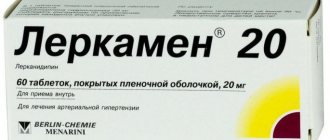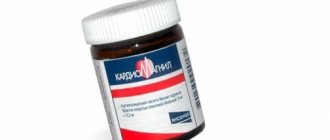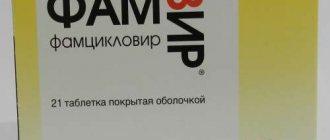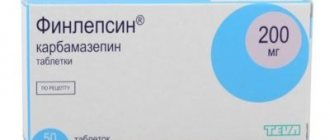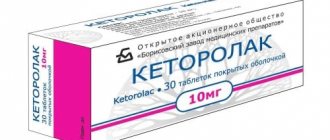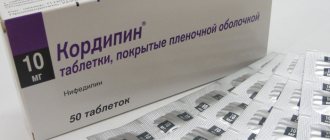Release form and composition
The drug is produced in film-coated tablets: blue, biconvex, oval (10 pieces in blisters, 1 or 2 blisters in a cardboard pack and instructions for use of Nalgesin).
Active ingredient: naproxen sodium, 1 tablet – 275 mg.
Excipients: purified water, talc, microcrystalline cellulose, magnesium stearate, povidone.
Shell composition: opadry YS-1-4215, consisting of hypromellose, titanium dioxide (E171), macrogol and indigo carmine dye (E132).
Analogs
Level 4 ATC code matches:
Artrum
Brustan
Ketonal Duo
Nurofen Plus
Nurofen Express
Nurofen Forte
Nurofen Express Lady
Nurofen for children
Nurofen
Ibuprom
Ibuprofen
Advil
Mig 400
Has
Ketoprofen
Vimovo
Naproxen
Flexen
Flamax
Novigan
The main analogues of the drug Nalgesin are:
- Naproxen;
- Promax;
- Cefekon.
Pharmacological properties
Pharmacodynamics
Naproxen is the active substance of Nalgesin, which has analgesic, antipyretic and anti-inflammatory effects. The mechanism of action is based on non-selective inhibition of the activity of cyclooxygenase 1 and 2 (COX-1 and -2).
The tablets dissolve well and are quickly absorbed from the gastrointestinal tract, which ensures a rapid onset of analgesic effect.
Pharmacokinetics
Absorption of naproxen from the gastrointestinal tract is rapid and complete, bioavailability is 95% (food intake has virtually no effect on the completeness and speed of absorption).
The time to reach the maximum concentration of the substance is from 1 to 2 hours, the connection with plasma proteins is more than 99%, the half-life is in the range of 12–15 hours.
Metabolism occurs in the liver to dimethylnaproxen; the CYP2C9 enzyme system takes part in the process. Clearance is 0.13 ml/min/kg.
Excretion: 98% – by the kidneys (of which 10% – unchanged), 0.5–2.5% – with bile. Equilibrium concentration is achieved after 2-3 days of therapy (after taking 4-5 doses).
In patients with renal failure, accumulation of metabolites may occur.
A word from the doctors: what do experts think about the described drug?
What reviews does this medication have from doctors? Most experts speak positively about the drug "Nalgesin". The advantage of the medicine is its release form. Depending on the type of pathology, the consumer can choose a larger or smaller dose of the medication.
Experts say that the drug almost never causes adverse reactions. However, it is possible that consumers simply did not seek medical help and fixed the problem on their own.
Doctors report that very often the use of the medicine leads to the complete elimination of disturbing symptoms. This happens with periodic pain in women, migraines and other types of pain. The drug is often prescribed after surgery. However, not all doctors approve of such a correction. Many experts tend to believe that the medicine may cause bleeding.
Indications for use
- Mild and moderate pain syndrome: lumbar ischialgia, ossalgia, neuralgia, myalgia, post-traumatic pain syndrome (bruises or sprains) with inflammation, adnexitis, algodismenorrhea, migraine, headache and toothache, as well as postoperative pain (in gynecology, orthopedics, traumatology, maxillofacial -facial surgery);
- Diseases of the musculoskeletal system: ankylosing spondylitis (ankylosing spondylitis), arthritis (juvenile chronic, psoriatic, rheumatoid, gouty), bursitis, tenosynovitis, rheumatic soft tissue lesions, osteoarthritis of the spine and peripheral joints (including with radicular syndrome);
- Infectious and inflammatory ENT diseases accompanied by severe pain (as part of complex therapy): tonsillitis, pharyngitis, otitis media;
- Feverish syndrome caused by infectious or colds.
Nalgesin is used for symptomatic therapy (i.e., to reduce inflammation and pain, reduce elevated body temperature). It has no effect on the progression of the disease itself.
Purpose of the drug
What are the indications for the medicine “Nalgesin”? The main points for taking the drug are described in the instructions. That is why it is necessary to study the annotation before use. The drug has anti-inflammatory, analgesic and antipyretic effects. It is used in the following cases.
- Flu and colds. If during an illness you feel weak, unwell, or have an increase in body temperature, then you can use Nalgesin. What does it help with? The product reduces temperature, relieves headaches and muscle pain, and improves overall well-being.
- Pain syndrome. If you have back pain, a migraine or a toothache, you can take medication. The medicine quickly relieves unpleasant symptoms, normalizing well-being.
- Women's testimony. The described medicine helps with periodic pain in women. In this case, the malaise may be associated with ovulation or menstruation.
- Bone diseases. Diseases such as radiculitis, arthritis, and so on are indications for the use of the medication. Nalgesin tablets only relieve the manifestations of the pathology, without eliminating its cause.
Contraindications
Absolute:
- Period of exacerbation of inflammatory bowel diseases (Crohn's disease, ulcerative colitis);
- Erosive and ulcerative lesions of the gastric and duodenal mucosa;
- Presence of gastrointestinal bleeding;
- The period after coronary artery bypass surgery;
- Cerebrovascular and other bleeding, hemostasis disorders;
- Inhibition of bone marrow hematopoiesis;
- Active liver disease or severe liver failure;
- Progressive kidney diseases, severe renal failure (creatinine clearance less than 20 ml/min), incl. confirmed hyperkalemia;
- Pregnancy and lactation;
- Children under 9 years of age and/or body weight up to 27 kg;
- The presence in the patient's medical history of data on the development of an attack of bronchial obstruction, urticaria, rhinitis after taking acetylsalicylic acid (ASA) or other NSAIDs;
- Hypersensitivity to the components of Nalgesin or other NSAIDs, including ASA.
Relative (special care must be taken during treatment due to the risk of complications):
- Cardiac ischemia;
- Cerebrovascular diseases;
- Congestive heart failure;
- Dyslipidemia/hyperlipidemia;
- Diabetes;
- Peripheral arterial diseases;
- Creatinine clearance from 20 to 60 ml/min;
- Anamnestic data on the development of ulcerative lesions of the gastrointestinal tract and/or the presence of Helicobacter pylori infection;
- Smoking;
- Severe somatic diseases;
- Bleeding disorders;
- Bronchial asthma;
- Elderly age;
- Frequent drinking of alcohol;
- Long-term use of NSAIDs;
- Concomitant treatment with the following drugs: selective serotonin reuptake inhibitors (for example, paroxetine, fluoxetine, sertraline, citalopram), oral glucocorticosteroids (for example, prednisolone), antiplatelet agents (for example, clopidogrel, ASA), anticoagulants (for example, warfarin);
- Children's age 9-12 years.
Nalgesin, instructions for use: method and dosage
Nalgesin tablets are taken orally.
When using the drug as an anesthetic, the average daily dose for adults is 550-1100 mg (2-4 tablets). For very severe pain, but provided there is no history of gastrointestinal diseases, the doctor may increase the dose to 1650 mg (6 tablets). However, Nalgesin can be taken at this dose for no more than 2 weeks.
When using Nalgesin as an antipyretic, you can first take 2 tablets at once, then you can take 1 tablet every 6-8 hours.
Recommended doses of Nalgesin for adults for other indications:
- Prevention of migraine attacks: 2 tablets 2 times a day. If within 4-6 weeks the intensity, frequency and duration of attacks do not decrease, the drug should be discontinued;
- The first signs of a migraine attack: 3 tablets once, if necessary, another 1-2 tablets, but not earlier than after 30 minutes;
- Menstrual pain, cramps and pain after insertion of intrauterine devices, other gynecological pain: initial dose - 2 tablets, subsequently - 1 tablet every 6-8 hours;
- Acute attack of gout: initial dose – 3 tablets, after 8 hours – 2 tablets, then – 1 tablet every 8 hours until the attack stops;
- Rheumatoid diseases: the average initial dose is 2-4 tablets per day (taken in the morning and evening, and the morning and evening doses do not have to be the same). For severe night pain and/or morning stiffness, for diseases in which the leading symptom is pain, as well as in cases where the patient is transferred to Nalgesin from other NSAIDs taken in high doses, the initial daily dose of naproxen can be increased to 3-6 tablets . Depending on the prevalence of symptoms, the daily dose may be changed by the doctor in the future.
For children over 9 years old (weighing at least 27 kg), Nalgesin is prescribed at a dose of 10 mg/kg/day, divided into 2 doses.
In elderly patients, lower doses are recommended.
Nalgesin price, where to buy
The average price of Nalgesin in Ukraine is 50 UAH. If we compare with how much the drug Nalgesin Forte , then the difference between them is approximately 20 UAH.
Nalgesin tablets in Moscow can be bought for 110 rubles.
- Online pharmacies in RussiaRussia
- Online pharmacies in UkraineUkraine
- Online pharmacies in KazakhstanKazakhstan
ZdravCity
- Nalgesin tablets 275 mg 20 pcs. JSC KRKA, d.d., Novo mesto
366 rub. order - Nalgesin Forte tablets p.p.o. 20 pcs. JSC KRKA, d.d., Novo mesto
RUB 443 order
- Nalgesin Forte tablets 550 mg 10 pcs. JSC KRKA, d.d., Novo Mesto
RUB 262 order
- Nalgesin tablets 275 mg 10 pcs. JSC KRKA, d.d., Novo Mesto
RUB 194 order
Pharmacy Dialogue
- Nalgesin (tablet p/o 275 mg No. 10)KPKA
RUB 214 order
- Nalgesin (tablet p/o 275 mg No. 20)KPKA
RUB 357 order
- Nalgesin forte (tablet p/o 550 mg No. 10)KPKA
RUB 311 order
show more
Pharmacy24
- Nalgesin 275 mg N10 tablets KRKA, Slovenia
48 UAH. order - Nalgesin 275 mg N20 tablets KPKA, d.d., Novo mesto, Slovenia
84 UAH order
- Nalgesin forte 550 mg N10 tablets KPKA, d.d., Novo Mesto, Slovenia
73 UAH order
- Nalgesin forte 550 mg N20 tablets KPKA, d.d., Novo Mesto, Slovenia
129 UAH order
PaniPharmacy
- Nalgesin tablets Nalgesin tablets No. 10 Slovenia, KRKA dd Novo Mesto
64 UAH order
- Nalgesin forte tablets Nalgesin forte film-coated tablets 550 mg No. 10 Slovenia, KRKA dd Novo Mesto
90 UAH order
show more
Side effects
- Digestive system: ulcerative stomatitis, nausea, diarrhea, dyspepsia, abdominal pain, constipation, erosive and ulcerative lesions and bleeding in the gastrointestinal tract, hematemesis, jaundice, melena, impaired liver function, increased activity of liver enzymes;
- Central nervous system: drowsiness, headache, depression, myalgia and muscle weakness, malaise, slow reaction speed, insomnia, aseptic meningitis, sleep disturbances, hearing loss, cognitive dysfunction, inability to concentrate, dizziness;
- Skin: purpura, increased sweating, alopecia, ecchymosis, photodermatoses, itching;
- Cardiovascular system: palpitations, vasculitis, shortness of breath, swelling, congestive heart failure;
- Genitourinary system: renal failure, nephrotic syndrome, renal papillary necrosis, hematuria, glomerulonephritis, interstitial nephritis, menstrual irregularities;
- Respiratory system: eosinophilic pneumonitis;
- Hematopoietic organs: thrombocytopenia, leukopenia, aplastic anemia, granulocytopenia, eosinophilia;
- Sense organs: tinnitus, hearing and vision impairment;
- Allergic reactions: epidermal necrosis, angioedema, urticaria, erythema multiforme, skin rash, Stevens-Johnson syndrome;
- Other: hypoglycemia, hyperglycemia, hemolytic anemia, hyperthermia, thirst.
Most often, side effects occur when taking Nalgesin in high doses.
Overdose
Main symptoms:
- Significant overdose: drowsiness, dyspeptic disorders (heartburn, vomiting, nausea, abdominal pain), weakness, tinnitus, irritability;
- Severe cases: melena, bloody vomiting, convulsions, impaired consciousness, renal failure.
Therapy: gastric lavage, symptomatic treatment, including the use of activated charcoal, antacids, H2 receptor blockers, proton pump inhibitors.
Hemodialysis is ineffective.
special instructions
To reduce the risk of side effects from the digestive system, it is recommended to use the minimum effective doses of Nalgesin in the shortest possible courses.
If fever and/or pain persist or worsen, discontinue the drug and consult a doctor.
Without a doctor's prescription, Nalgesin should not be taken simultaneously with other analgesics or anti-inflammatory drugs.
In case of planned surgery, Nalgesin should be discontinued 48 hours in advance. The same applies to conducting a study to determine 17-corticosteroids, as well as 5-hydroxyindoleacetic acid in the urine.
Patients following a diet with limited salt intake should note that each Nalgesin tablet contains 25 mg of sodium.
Impact on the ability to drive vehicles and complex mechanisms
Naproxen has a negative effect on the speed of reactions, which should be taken into account by vehicle drivers and people employed in industries that require increased attention.
What to replace the medicine with?
The medicine "Nalgesin" has analogues. They can be relative or absolute. Before replacing this product, you should consult a doctor. When purchasing medicine, pay attention to the dosage of the drug. It can also be very different. Among the medications with the same active ingredient one can highlight “Sanaprox”, “Naprios”, “Pronaxen” and so on.
You can also purchase other non-steroidal anti-inflammatory drugs. For example, “Ibufen”, “Nurofen”, “Spazmalgon”, “Nimulid”, “Nise”. They all have their own contraindications and method of use. Read the instructions before use.
Drug interactions
- Anticoagulants: increased bleeding time;
- Other NSAIDs: risk of side effects;
- Propranolol and other beta-blockers: reduction of their antihypertensive effect, risk of developing renal failure;
- Furosemide: suppression of its natriuretic effect;
- Lithium preparations: increasing the concentration of lithium in the blood plasma;
- Probenecid: increased plasma levels of naproxen;
- Cyclosporine: risk of renal failure;
- Phenytoin, methotrexate, sulfonamides: slowing their excretion, risk of developing their toxic effect;
- Magnesium- and aluminum-containing antacids: decreased absorption of naproxen.
